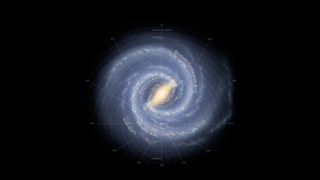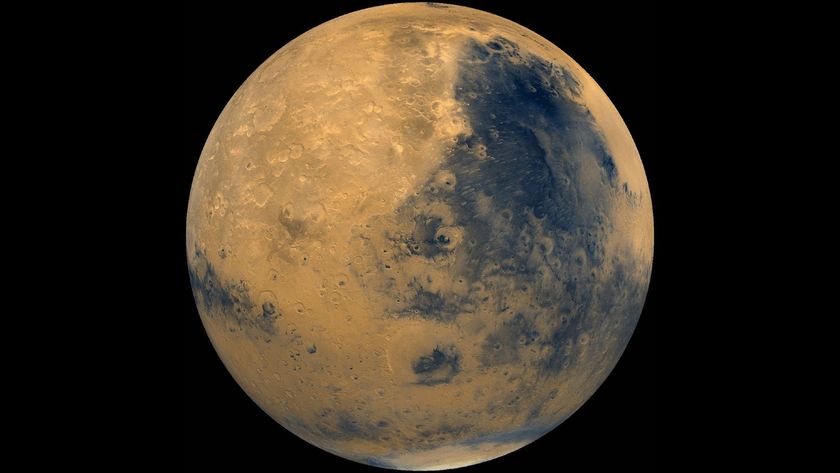Huge Milky Way Gas Bubbles Clocked at 2 Million Mph

Giant bubbles of gas that erupted from the core of the Milky Way galaxy millions of years ago are expanding out into space at mind-blowing speeds, according to new observations that may help reveal how the strange balloon-like lobes formed.
Scientists using the Hubble Space Telescope have clocked the speed of gas bubbles, known as Fermi bubbles, at a whopping 2 million mph (3.2 million km/h). The giant structures now extend 30,000 light-years above and below the plane of the Milky Way.
"A few million years ago, there was a very energetic event at the galactic center, and we're seeing a remnant," lead author Andrew Fox, of the Space Telescope Science Institute in Baltimore, Maryland, said at a press conference this month. [The Strangest Things in Space]
Fox presented the new Hubble observations at the 225th meeting of the American Astronomical Society in Seattle, revealing the , and agethe Fermi bubbles.
Piercing the dust and gas
Fermi bubbles were first discovered in 2010 by scientists using NASA’s Fermi Large Area Telescope, which revealed two lobes of material protruding from the center of the Milky Way. Since then, the features have been studied in the X-ray and radio wavelengths.
Fox and his team paired Hubble's Cosmic Origins Spectrograph with a distant quasar to measure the speed and composition of the billowing bubbles. A quasar is a very bright source of light generated by fast-moving particles near a supermassive black hole inside a distant galaxy. Light from the quasar is so strong that it outshines its parent galaxy. The scientists measured how the ultraviolet light from quasar PDS 456 shifted as it passed through the base of the northern bubble.
With the help of the bright quasar, the team determined that material on the near side of the northern lobe is streaming toward the sun, while material on the far side is zipping away. The material is gushing out of the Milky Way at approximately 900 to 1,000 kilometers per second, or about 2 million mph.
Get the Space.com Newsletter
Breaking space news, the latest updates on rocket launches, skywatching events and more!
At this rate, the scientists calculated that the event that created the lobes occurred between 2.5 and 4 million years ago.
In addition to measuring its speed, the new Hubble observations also determined that the material swept up by the gas was made up of silicon, carbon and aluminum. This composition suggests that the gas is enriched by heavy elements that are forged within stars, and represents the fossil remnants of star formation.
The gas studied by Fox's team reaches temperatures of 17,500 degrees Fahrenheit (9,700 degrees Celsius). Far cooler than the rest of the gas in the outflow, which reaches temperatures of around 18 million degrees F (10 million degrees C), the cooler gas may be interstellar gas from the Milky Way that has been swept up in the hot outflow, Fox said. [Stunning Photos of Our Milky Way Galaxy (Gallery)]

A front-row seat
In other galaxies, starbursts drive outflows of gas that resemble Fermi bubbles, but these features are difficult to study from so far away. The Milky Way's Fermi bubbles provide an up-close look at these formations.
"We have a front-row seat. We can study the details of these structures," Fox said in a statement. "We can look at how big the bubbles are and how much of the sky they are covering."
PDS 456 is the first of 20 quasars whose light passes through the lobes. Studying the entire sample will allow astronomers to further narrow down the source of the event that generated the Fermi bubbles.
One potential cause of the outflows is rapid star formation at the galactic center. This birth of stars produced a series of supernovas that blew out a significant supply of gas. Another explanation involves the fall of a star or group of stars into the supermassive black hole at the center of the galaxy, causing superheated gas to be blasted into space.
Whatever the cause, the short-lived nature of the bubbles (when compared with the 13.2-billion-year-old age of the galaxy) suggests that they may be repeating phenomena, occurring frequently throughout the life of the Milky Way.
"It looks like the outflows are a hiccup," Fox said in the statement. "There may have been repeated ejects of material that have blown up, and we're catching the latest one. By studying the light from the other quasars in our program, we may be able to detect the fossils of previous outflows."
The study will be published in the Astrophysical Journal Letters, and is available online in preprint form.
Follow us @Spacedotcom, Facebook and Google+. Original article on Space.com.
Join our Space Forums to keep talking space on the latest missions, night sky and more! And if you have a news tip, correction or comment, let us know at: community@space.com.

Nola Taylor Tillman is a contributing writer for Space.com. She loves all things space and astronomy-related, and enjoys the opportunity to learn more. She has a Bachelor’s degree in English and Astrophysics from Agnes Scott college and served as an intern at Sky & Telescope magazine. In her free time, she homeschools her four children. Follow her on Twitter at @NolaTRedd










